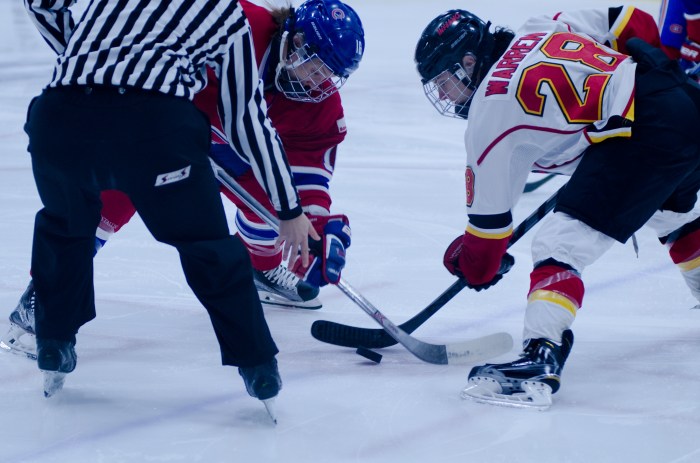
Sarah Lefort of Les Canadiennes facing off against Louise Warren of the Calgary Inferno at Place Bell on October 14th, 2018. Photo by Courtney Szto.
“The story of women’s hockey is a tale of unimaginable progress while at the same time only scratching the surface of how far there is to go” (Alana Paterson, Globe and Mail, 2017).
The CWHL has a new commissioner in Jayna Hefford and the timing couldn’t be more perfect. Hefford is just the league’s second commissioner following Brenda Andress. Now, I don’t believe that one has to have played the game at its highest levels to be able to preside over it but, in this case, having a player with Hefford’s resume is (I hope) a win for women’s hockey.
Women’s hockey exists in, what feels like, a pivotal moment right now. A lot of it has to do with marketable stars such as Marie-Philip Poulin and Hilary Knight but it also has to do with life more broadly in 2018. Social media, live streaming, the #MeToo and #TimesUp movements, and governmental politics in both Canada and the United States are all coalescing to create civil unrest that we haven’t really seen since the 1960s. At the very least, there exists a sense of resistance now that I have never experienced. People are fed up with the status quo in film, in politics, in media, and in sports. The USWNT boycott of the 2017 World Championship (followed up by Olympic gold) was a perfect indicator that women (in sports) are done being satisfied with the crumbs from men’s sports, and social media proved key in their solidarity and empowerment. American gymnastic Olympic powerhouse, Simone Biles just took out the USA Gymnastic’s interim CEO with a tweet! Collective rage, if you will, can be very useful because, as author Rebecca Solnit (2005) has written, optimism is often cause for inaction, but:
To hope is to gamble. It’s to bet on the future, on your desires, on the possibility that an open heart and uncertainty is better than gloom and safety. To hope is dangerous, and yet it is the opposite of fear, for to live is to risk. (p.5)
Women athletes are starting to collectively demand more and it is time that Canadian athletes join some of the public outcry to demand more and better. When I teach about athlete activism it is disappointing that my students have very few Canadian role models upon which to draw. Women’s hockey can change this should they refuse to be content and safe; it’s time to gamble.
The CWHL is made possible, not by the Olympic stars that pepper the league rosters but by the majority of players who work full time jobs and sacrifice their evenings, weekends, and, I can only assume some of, their sanity, to play the game that they love. I have written about this very gendered and unequal distribution of labour before and I’ll continue mentioning it every opportunity I get until it is rectified (2011) (2018). Post-game autograph sessions for the home team are part of the CWHL job description. The NHL, on the other hand, works very hard to shield its players (and their time) from the public, despite the fact that they have far more time to give and are paid exponentially more to “entertain” us. A post-game sit down autograph session seems like a pretty small task when you are getting paid six, seven, eight figures. Admittedly, the NHL doesn’t necessarily need more fan support but if we are going to talk about labour then we need to have a comprehensive understanding of it beyond the 60 minutes that takes place on the ice. We consistently ask more of women’s time and give them less in return.
Please note that this is not an indictment of the CWHL, rather of a society that is willing to invest their sponsorship dollars on any men’s sports franchise/event but feels that women’s sports are too “risky” to support or because they don’t have a “proven” market, both of which are sexist deflections. Men’s sports are not guaranteed investments but sponsors are willing to take the risk because the possibility of losing a few dollars on men is framed as the way that business works; yet, the possibility of losing dollars on women’s sports simply proves that they were never worthy of support in the first place. Women have never had the luxury (nay, privilege) of mediocrity or failure. It is a fallacy that there needs to be a certain level of interest before the media can provide meaningful coverage and sponsors will invest. We know this because we can (and do) create interest in sports all the time. The World Junior’s didn’t become a TSN mainstay production until someone decided to make it so. The X Games has it written explicitly in its history: “ESPN management decides to devote significant resources to the creation of an international gathering of action sports athletes.” This decision helped elevate sports such as snowboarding and its athletes to new levels. Similarly, there was no great public desire to watch darts on television until someone decided to give it air time. Darts, people. Darts. And, as far as women’s hockey is concerned we already know that a viable market exists because we see it emerge every time Team USA and Team Canada face-off.
When women’s sports is aired on TV people take notice — and they like it! From women’s soccer, to women’s tennis, to the WNBA, increasing television consumption has demonstrated that people want access to women’s sports. Yet, even though I pay for additional sports channels I often find the SAME men’s game on all of them with no women’s sports in sight. I don’t fully believe in the adage of “you can’t be what you can’t see,” but there is certainly some truth to the statement. For example, did you know that during the 2015-2016 season there was an inaugural Women’s Winter Classic held before the Men’s Winter Classic? Don’t feel bad if you missed this game because it wasn’t televised, there were no tickets sold (those who had tickets for the alumni game could also use the ticket for the women’s game), and they were only allowed to play two 15-minute periods *insert face to desk here*. Cheryl MacDonald, Jon Edwards, and I were so disappointed by what was supposed to be a showcase of women’s hockey that we penned an entire chapter about the historic game that no one saw to ensure that it literally wasn’t forgotten (Chapter 6).

Les Canadiennes goalie, Emerance Maschmeyer being semi-screened by Venla Hovi of the Calgary Inferno. Photo by Courtney Szto.
The CWHL has always been a great product and credit to Andress for getting it to where it is today, but we have a long way to go. For a country that prides itself on hockey as part of its national fabric, it should also be abundantly clear that we really mean men’s hockey save for the women’s gold medal game every four years. As Mary Louise Adams put it so eloquently twelve years ago, “If hockey is life in Canada, then life in Canada remains decidedly masculine and white” (p.71). When we ask which people get the privilege of representing the Canadian nation through the sport of hockey, we find a far less equitable Canada than we like to present with respect to gender, race, and ability. Hockey needs to do better and I think the CWHL is well positioned to lead these changes because of its size, because it houses some of the most eloquent, educated, and charismatic athletes on this planet, because these women still pick up their own pucks after warm-ups, and because when I ordered some hats from Mélodie Daoust she filled the order herself. These women are awesome-sauce.
A league merger with the NWHL, a living wage, and consistent television coverage (not JUST streaming) are obviously at the top of the new Commissioner’s to-do list, still there are other considerations that will determine the sustainability of women’s professional hockey. Do CWHL players receive pensions? My understanding is no (and if I’m wrong that’s great) but this really needs to be part and parcel of the living wage conversation. Professional sports is too unpredictable and demanding to not provide some semblance of a safety net for athlete contributions and sacrifices. This is one of those instances where aiming higher than what the men have achieved would be beneficial because the NHL doesn’t have a great pension plan as it is.
The other major issue facing women’s hockey that needs to be addressed in order to secure its longevity is the overwhelming whiteness on the ice, behind the bench, and in the offices. We like to say that “hockey is for everyone” but this is more of an aspirational tagline than it is an accurate status update. We need to say “hockey is for everyone” as a reminder because it is not yet for everyone. My own research has demonstrated that the current hockey system tends to filter South Asian women from the game because (1) coaches don’t seem to give South Asian players the same attention and support that white players receive, (2) scouts still seem to carry the idea that “Asians don’t know hockey,” and (3) having racist epithets hurled at you on the ice from opposing teams can wear on a person’s psyche. It is often assumed that as more racialized people enter the game that diversity will filter upwards. Sadly, this logic is flawed because more people has never resulted in more equality. Here is a photo from the 2018 U-18 development camp:

U-18 girl’s development camp in Banff. Photo from Twitter @HC_Women.
These young women represent the future of hockey in Canada but they are far from representative of the Canadian populace. Equality, when done well, must be a concerted effort. It is an all-encompassing endeavour that too often only incorporated at the grassroots levels of the game. Outside Magazine is probably one of the best examples of how quickly an organization can change its narrative, its workforce, and its priorities to produce a more representative and equitable product with respect to race, gender, and ability. Change doesn’t have to take an entire generation. (Pro Tip 1: hire someone like Toronto-based sports journalist and activist, Shireen Ahmed who knows a wee-bit about the sports. Pro Tip 2: Land acknowledgements before the start of games would go a long way towards addressing sport’s roll in achieving the TRC’s Calls to Action.) Scoring records and championships are always meant to be overwritten but progressive changes to the game itself are resume lines that live in perpetuity.
This is a call to action for potential sponsors, to the media, the CWHL, and to fans of hockey (that’s right, not women’s hockey – just hockey!). To sponsors: get your cheque books out and invest in tomorrow, today. Don’t get left behind. To the media: write about them, highlight them, and share their stories with the same attention, excitement, and production value that have become the hallmarks of men’s sports. Help create interest in women’s hockey instead of just waiting for it to emerge. To Commissioner Hefford: rock the boat because (relatively) smooth seas have left us with far too much ground to make up. And, to the fans: show your support in person, on social media, and with your dollars if you are able. Pack the stands (individual game tickets are $15, seasons tickets range from $137-175 Toronto Furies, Les Canadiennes, Calgary Inferno, Markham Thunder, Worcester Blades) share their news, wear the merchandise, and attend their clinics [Montreal: Adults – Kids] [Toronto] [Calgary] [Markham].
The stage is set for a new chapter. Let’s not waste this opportunity.
Now you get to enjoy some photos from the October 14th game between Les Canadiennes and the Calgary Infero, a game that featured 15 Olympians.
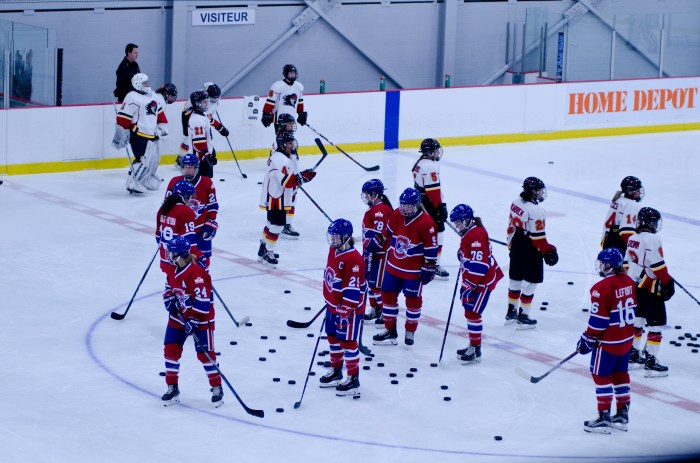
Warm Up. Photo by Courtney Szto.
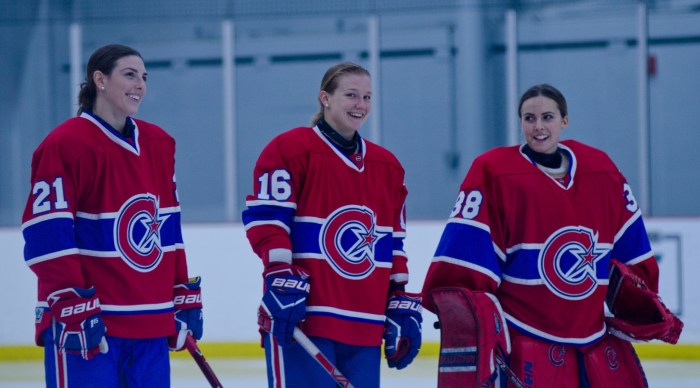
Left to Right: Hilary Knight, Sarah Lefort, Emerance Maschmeyer. Photo by Courtney Szto.

Packed stands at Place Bell’s community rink. Photo by Courtney Szto.

Jill Saulnier recently acquired from, none other than, the Calgary Inferno. Photo by Courtney Szto.
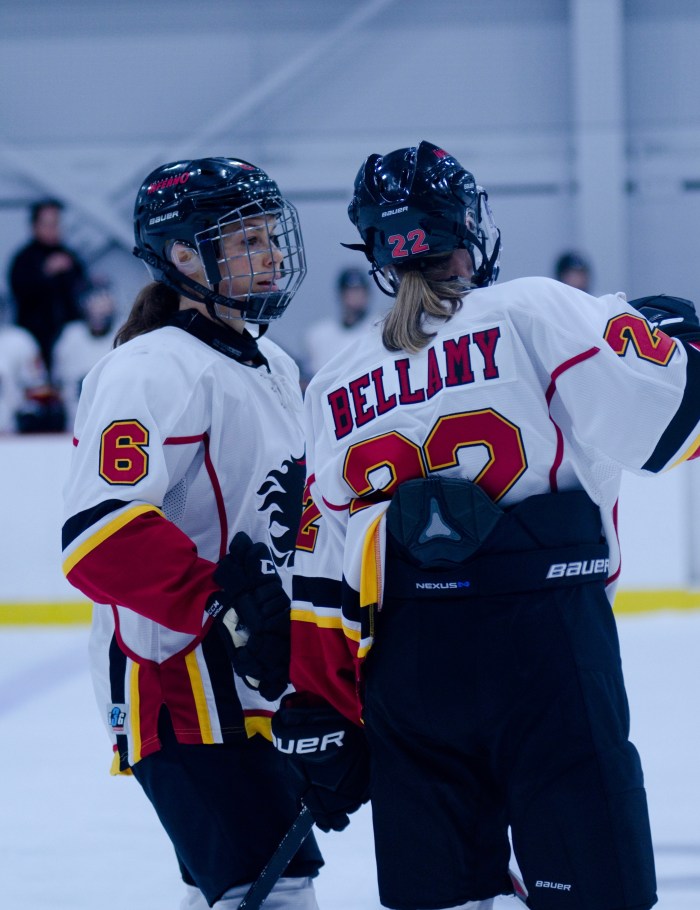
Canada-US relations doing A-okay here! Rebecca Johnston and Kacey Bellamy discussing strategy…or maybe their favourite salad dressing? I couldn’t hear so it could really be about anything. Photo by Courtney Szto.

Intermission fist bumps all around. Photo by Courtney Szto.

A captain’s work is never done. Marie-Philip Poulin mentally preparing for the third period. Photo by Courtney Szto.
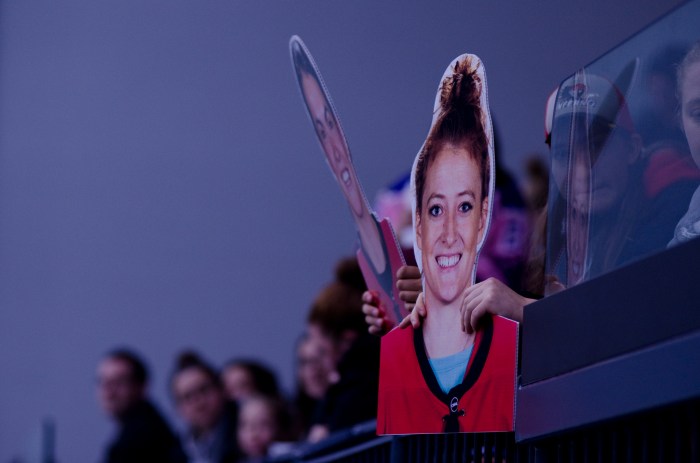
You know fans are dedicated when they bring enlarged cut-outs. Dakota Woodworth # 9 and Blayre Turnbull #40 of the Calgary Inferno. Photo by Courtney Szto.
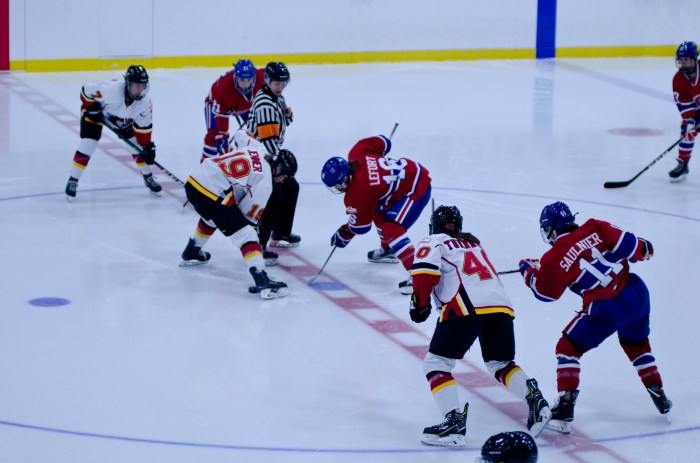
Third period face-off. Photo by Courtney Szto.

Julie Chu is no longer on the roster but is still in the heart’s of many Les Canadiennes fans. Photo by Courtney Szto.

Rebecca Johnston creating trouble for Les Canadiennes defence. Photo by Courtney Szto.
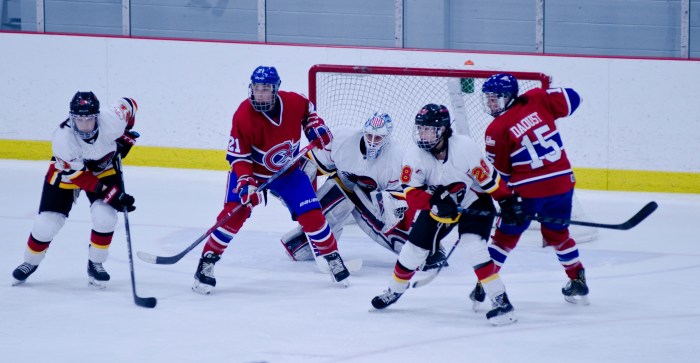
Alex Rigsby trying to find a sight line with Hilary Knight and Mélodie Daoust in prime rebound territory. Photo by Courtney Szto.
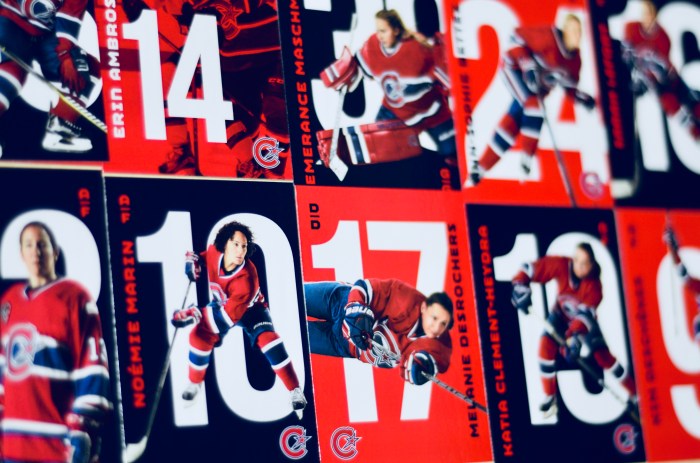
Now if we could only get these included in the Tim Horton’s packs. Photo by Courtney Szto.
Works Cited
Adams, M. L. (2006). The game of whose lives? Gender, race, and entitlement in Canada’s “national” game. In D. Whitson & R. Gruneau (Eds.), Artificial ice: Hockey, culture, and commerce(pp. 71–84). Toronto, Canada: Broadview Press.
MacDonald, C., Szto, C. & Edwards, J. (2017). The Game That No One Saw: Evaluating the cultural citizenship and legitimacy of women’s professional hockey through the Inaugural Women’s Winter Classic. In A. Milner & J.H. Braddock II (eds.), Women in Sports: Breaking Barriers, Facing Obstacles. Santa Barbara, CA: ABC-CLIO.
Solnit, R. (2005). Hope in the Dark: The Untold History of People Power. New York: Canongate.


Pingback: Myth Busting, Part 1: “No one wants to watch women’s hockey” | Hockey in Society
Pingback: PWHL: Where past, present, and future meet | Hockey in Society / Hockey dans la société